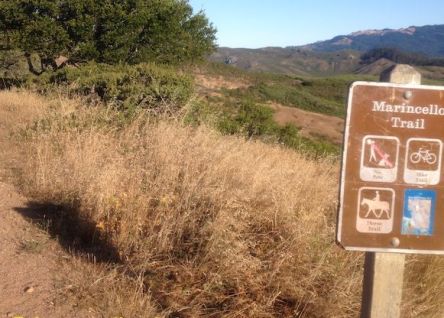MarinScope
TUESDAY, NOVEMBER 13, 2013
by Brad Hathaway
In 1970, what is now CalTrans took a utilitarian piece of infrastructure and turned it into a landmark, comining the uniquely Marin-ish mixture of whimsey and wonder with the utility of a major highway structure.
As Alan S. Hart, the director of the San Francisco District of California’s Division of Highways, prepared to retire, he and his public information officer, Robert Halligan, came up with the idea of painting the southern portals of the Waldo Tunnels of U. S. Route 101 with a rainbow of colors. Hart didn’t bother to clear the idea with his superiors in Sacramento and it is reported that they were not pleased – but the public reaction was so positive they let the colors remain.
Originally, there had been just one tunnel. It was constructed in 1937 as part of the Golden Gate Bridge project to connect San Francisco with Marin County and the rest of Northern California. The tunnel was 1,000 feet long and the elevation at the entrance was 517 feet above sea level. It cost $630,346 in depression-era dollars.
By the 1950s the single, four lane tunnel had become something of a bottleneck sitting as it did just north of the six lane Golden Gate Bridge on the Redwood Highway. A second tunnel was drilled in 1954 so that the highway could handle four lanes in each direction. The cost of that second tunnel came in at $1,750,000.
After the portals to the tunnels took on the spectrum of the rainbow, legends that seem to die hard sprang up about hippies sneaking out in the middle of the night to surreptitiously apply the paint. After all, the age of flower-power and psychedelic color schemes was at its peak. The fact that no crew could have done the work in a single night didn’t seem to keep that legend from spreading.
As the fame of the tunnels grew, the rainbows became part of the area’s self-image, and the drive under the rainbow became a delight both for commuters approaching home and for tourists following the Redwood Highway to the north.
But time took its tole on the vibrancy of the rainbow spectrum. The paint faded badly. In the 1980s CalTrans repainted the portals, but by 2009 they needed another coat.
Enter Belinda Hallmark, a color consultant from Novato.
Hallmark read that CalTrans was planning on renewing the paint job and thought she might be able to be of assistance. After all, as a color consultant she knew a great deal about how different colors would go together and how different paints would behave.
Of course, a rainbow would include red. But which red? Green, but what shade of green? Yellow, but would the yellow be lemony or golden?
Hallmark feared that simply applying bands of primary colors might end up with the tunnels looking “more like a roll of Life Savers than like rainbows,” so she contacted CalTrans to offer her services – gratis.
With the cooperation of the paint team of CaTrans’ Maintenance Division 4, plans were laid for the job. Hallmark painted test swatches to judge not only how different colors would work together, but how they would behave in the wide range of lighting conditions the weather offers for those south-facing arches: direct sun through morning mists, sharp twilight shadows, rolling fog banks and wind-driven rains. As often as three times a day she would drive Route 101 to check the samples.
Not only did Hallmark help determine the colors to be used, she chose the paint and even got it donated for the project. Benjamin Moore’s Aura was the paint of choice and the company donated half of the paint required for the job. Their generosity was matched by Marin Color Services, Inc., the Benjamin Moore outlet in San Rafael and Novato.
There was thought about painting the north side portals as well, but they were in sight of private residences and not all the homeowners thought seeing painted rainbows was the view they wanted.
Hallmark convinced CalTrans officials that the north face of the tunnel and not just the arched portals shoud be painted. She chose a green for the flat surface and a grey tone for the pop-out concrete blocks. This was to provide a more distinct background for the rainbows.
In all, it took 30 gallons of paint for the rainbows themselves, 40 gallons for the wall surfaces as well as a total of 40 gallons of primer, and an additional 20 gallons of clear sealer for the rainbows.
CalTrans’ Jeff Buttte and his Richmond/Sn Rafael Bridge Painting Crew did the work in September and October of 2009 at a cost of about $142,000 for the 3,000 hour job. That included a dozen painters and a half-dozen person lane closure/traffic control crew. In all, almost 10,000 square feet of surface outside and within the tunnels were coated.
Hallmark still drives up to look at how the rainbows have fared. “There’s no sign of fading” to date, she says.
A sentiment echoed by my granddaughters who love to go through the Rainbow Tunnel!
 Wednesday, June 4, 2014 at 01:31PM
Wednesday, June 4, 2014 at 01:31PM 

